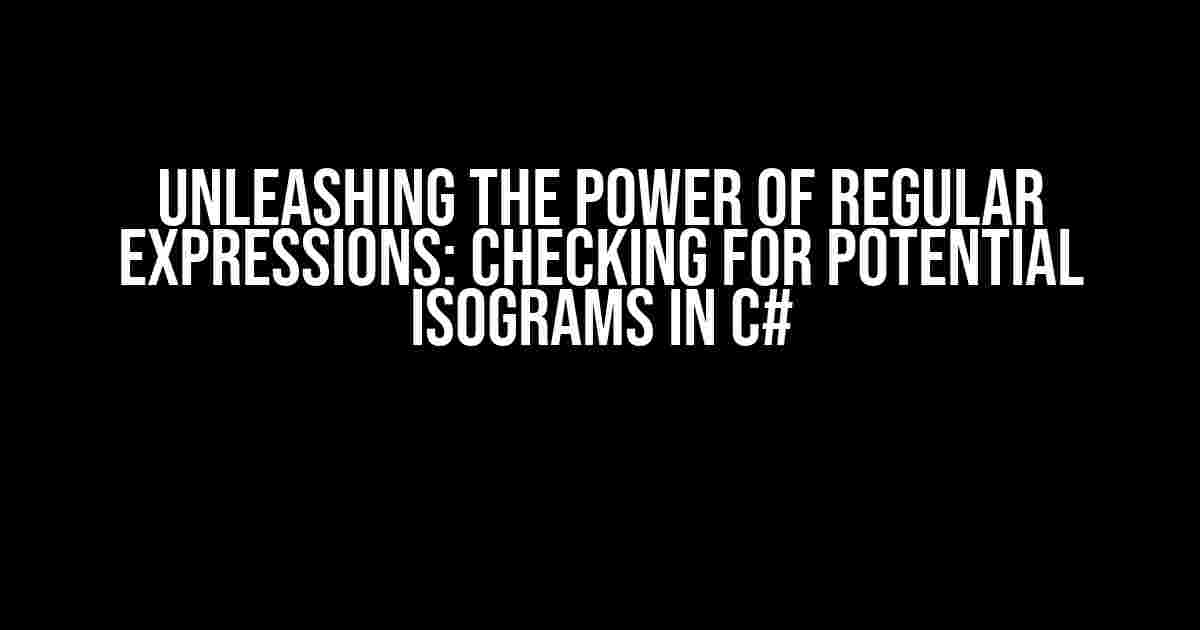In the realm of string manipulation, regular expressions (regex) reign supreme. They offer a powerful way to search, validate, and extract data from strings. In this article, we’ll embark on a journey to create a regular expression to check for potential isograms in C#, a task that may seem daunting at first, but fear not, for we’ll break it down into manageable chunks.
What are Isograms?
Before we dive into the world of regex, let’s understand what isograms are. An isogram is a word or phrase that has no repeating letters, ignoring case and ignoring spaces and punctuation. For example, “listen” and “silent” are isograms, whereas “hello” is not, due to the repeated “l”.
Why do we need a regular expression for isograms?
A regex-based solution offers several advantages:
- Efficient: Regular expressions can process large amounts of data quickly and efficiently.
- Flexible: Regex patterns can be adapted to accommodate various types of inputs and edge cases.
- Reusable: Once crafted, a regex pattern can be reused throughout your codebase.
Creating the Regular Expression
To create a regular expression that checks for potential isograms, we’ll need to consider the following factors:
- Ignoring case
- Ignoring spaces and punctuation
- Detecting repeated characters
Let’s break down the regex pattern step by step:
string pattern = @"^
(?:
(?<> [a-z] ) // Capture a character ( ignoring case )
(?! // Start a negative lookahead
(?:
\1 // Refer to the captured character
(?>.*\1) // Match any character (including newline) followed by the same character
)
)
)*
$";
Let’s dissect this pattern:
| Regex Element | Explanation |
|---|---|
^ |
Start of the string |
(?: |
Non-capturing group to group the pattern |
(?<> [a-z] ) |
Capture a character (ignoring case) |
(?! ... ) |
Negative lookahead to ensure the character is not repeated |
(?: \1 (?>.*\1) ) |
Match any character (including newline) followed by the same character |
)* |
Zero or more occurrences of the pattern |
$ |
End of the string |
Using the Regular Expression in C#
Now that we have the regex pattern, let’s create a C# method to check for potential isograms:
using System.Text.RegularExpressions;
public static bool IsIsogram(string input)
{
string pattern = @"^(?:(?<>[a-z]) (?! (?:(?<>.*?\1) ))) $";
return Regex.IsMatch(input, pattern, RegexOptions.IgnoreCase);
}
In this example, we’re using the `Regex.IsMatch` method to test the input string against the regex pattern. The `RegexOptions.IgnoreCase` flag is used to make the match case-insensitive.
Testing the Method
Let’s test our `IsIsogram` method with some examples:
string[] testCases = new string[]
{
"listen",
"silent",
"hello",
"abcde",
"abcdefg",
"aabbcc",
" xyz "
};
foreach (string testCase in testCases)
{
Console.WriteLine($"{testCase}: {(IsIsogram(testCase) ? "Is an isogram" : "Is not an isogram")}");
}
The output should be:
listen: Is an isogram
silent: Is an isogram
hello: Is not an isogram
abcde: Is an isogram
abcdefg: Is an isogram
aabbcc: Is not an isogram
xyz : Is an isogram
Conclusion
In this article, we’ve successfully created a regular expression to check for potential isograms in C#. By breaking down the pattern into its constituent parts, we’ve made it more manageable and easier to understand. Remember, regex patterns are like puzzles – once you understand the pieces, you can create powerful solutions to complex problems.
Now, go forth and regex-ify your code!
Frequently Asked Question
Get ready to master the art of regular expressions in C# and uncover the secrets of identifying potential isograms!
What is an isogram, and why do I need to check for it in C#?
An isogram is a word or phrase without a repeating letter, ignoring case sensitivity and spaces. In C#, you might need to check for potential isograms when validating user input, generating random words, or creating word games. Regular expressions provide an efficient way to achieve this task.
How do I write a regular expression in C# to check for potential isograms?
You can use the following regular expression in C#: `^(?!.*([a-z]).*\1)[a-z]+$`. This pattern checks if a string contains any repeating letters, ignoring case sensitivity and spaces. The `^` symbol marks the start of the string, `.*` matches any characters, `([a-z])` captures a letter, `.*` matches any characters again, `\1` refers to the captured group, and `$` marks the end of the string.
How can I ignore case sensitivity when checking for isograms in C#?
To ignore case sensitivity, you can use the `RegexOptions.IgnoreCase` flag when creating a new `Regex` object in C#. This will ensure that the regular expression treats uppercase and lowercase letters as equivalent. For example: `var regex = new Regex(@”^(?!.*([a-z]).*\1)[a-z]+$”, RegexOptions.IgnoreCase);`
Can I use this regular expression to check for isograms in other programming languages?
While the regular expression itself is language-agnostic, the implementation details may vary. The pattern `^(?!.*([a-z]).*\1)[a-z]+$` should work in most languages that support PCRE (Perl-Compatible Regular Expressions) or similar syntax. However, you’ll need to adapt the code to your target language’s regex implementation and flags.
Are there any edge cases or limitations to this regular expression?
Yes, this regular expression assumes that the input string contains only letters. If you need to handle strings with punctuation, digits, or other characters, you’ll need to modify the pattern accordingly. Additionally, this regex does not account for Unicode characters or diacritics, so you may need to add additional logic or character classes to accommodate these cases.
